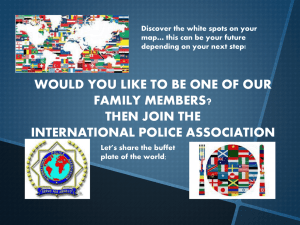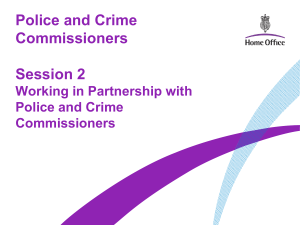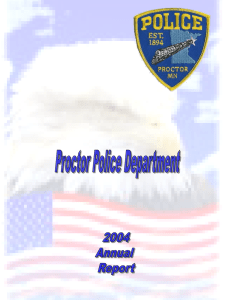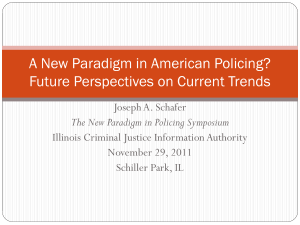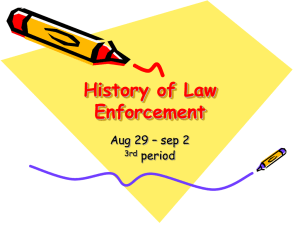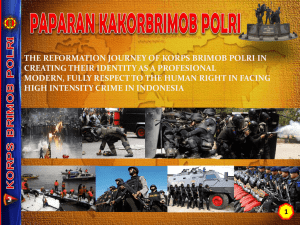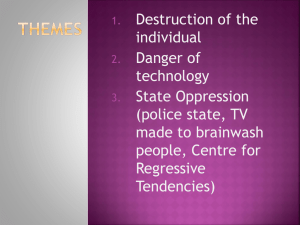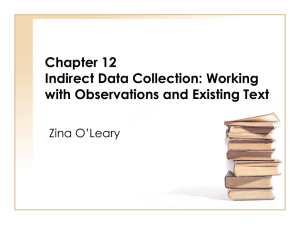Chapter 4: Policing
advertisement
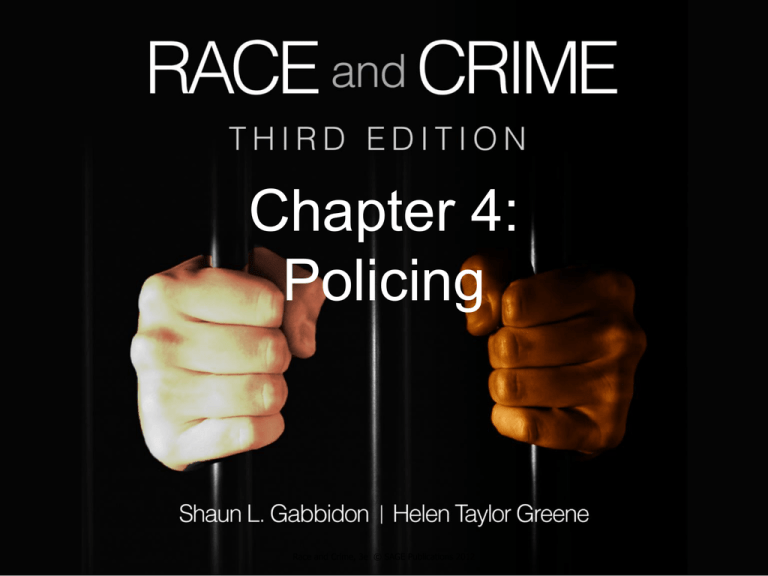
Chapter 4: Policing Race and Crime, 3e © SAGE Publications 2012 Introduction Police are on the front line of the criminal justice system. Confidence in police varies: In 2003, 92% of Whites had either a great deal or some confidence in the police. Only 80% of minorities and 73% of Blacks did. In 2011, reported confidence in the police (i.e., a great deal or some) hadn’t changed in all groups: 92% of Whites 73% of minorities 74% of Blacks Police agencies are more diversified, professional, and technologically advanced than ever. http://www.youtube.com/watch?v=tWhYmb1sANM Race and Crime, 3e © SAGE Publications 2012 Overview of Policing in America Police are the most visible symbol of governmental authority. There are numerous federal, local, and state agencies, which vary in size and are bureaucratic and quasi-military in structure. There are Native American (tribal) police agencies, special police agencies with limited jurisdiction (for example, transit police), and private police. Race and Crime, 3e © SAGE Publications 2012 Overview of Policing in America, cont. In 2004, there were: 12,575 local agencies 463,000 full-time sworn personnel 3,000 sheriffs’ offices 49 state agencies 1,481 special jurisdiction agencies 513 other agencies (such as constables) The 2004 Census of Federal Law Enforcement Officers identified: 105,000 full time personnel authorized to arrest and carry firearms. The U.S. Customs and Border Protection (CBP) and U.S. Immigration And Customs Enforcement (ICE) employ more than 38,000 officers. Race and Crime, 3e © SAGE Publications 2012 Race and Policing: A Historical Context Like their British counterparts, the colonists initially made policing the responsibility of every citizen. Later utilized the sheriff, constable, and watch system. American policing during the nineteenth century had separate forces in separate cities. The first African American police were “free men of color” who served in police organizations in New Orleans, Louisiana (1805 - 1830). They were responsible for slaves. Race and Crime, 3e © SAGE Publications 2012 Race and Policing: A Historical Context, cont. The three eras in the history of policing: 1. Political (1840s to early 1900s) 2. Reform (1930 to 1960s) 3. Community problem-solving (1970s to present). During the 1960s, police were closely scrutinized following a great deal of civil unrest and several U.S. Supreme Court decisions including: Mapp v. Ohio (1961) Escobedo v. Illinois (1964) Miranda v. Arizona (1966) Race and Crime, 3e © SAGE Publications 2012 Native Americans The act of May 19, 1796, set the boundary between Indian country and the United States. In 1799, the boundary was changed to give federal courts jurisdiction over U.S. citizens who committed crimes against Indians. The act of March 3, 1817, further extended federal law to prevent “White desperados” from escaping federal and state law. Following the Civil War, the United States minimized the political autonomy of tribal leaders and encouraged government representatives to deal with individual Indians and families. Race and Crime, 3e © SAGE Publications 2012 Native Americans, cont. In 1887, the General Allotment or Dawes Act permitted tribal lands to be allotted to individual Indians, making them landowners and farmers. The Dawes Act was extended to the Five Civilized Tribes in Indian Territory by the Curtis Act of 1898. Cherokees Choctaws Creeks Chickasaws Seminoles In the 1990s, more than 56 million acres of land were owned and policed by tribal nations in the United States. Race and Crime, 3e © SAGE Publications 2012 Native Americans, cont. “Indian country” includes reservations in 34 states, most of which are located west of the Mississippi River. There are several administrative arrangements for policing Native Americans that include cross deputization agreements with several entities. Race and Crime, 3e © SAGE Publications 2012 African Americans During the antebellum period, slaves were unprotected from crimes by slave owners, including murder, rape, assault, and battery. By the mid-1700s, “patterrollers,” or slave patrols, the first distinctively American police system, existed in every southern colony. The first wave of Black police officers in the United States appeared during Reconstruction. Chicago, Philadelphia, Columbia and Charleston, South Carolina, and cities in Mississippi and Texas. African Americans, cont. Early race riots in the 19th and early 20th century were clashes between Blacks and White citizens, in which the police were accused of indifference, brutality, and leaving the scene. Riots continued throughout 20th century. 1970s African Americans moved into more administrative roles in police agencies. Race and Crime, 3e © SAGE Publications 2012 Asian Americans Little information exists on Asian experiences with the police. Many Chinese immigrated to California in search of gold. Chinese were also known to serve as cooks, laundrymen, and servants. Early laborers were indentured servants who financed their passage by agreeing to work for merchant-creditors. Race and Crime, 3e © SAGE Publications 2012 Asian Americans, cont. After the anti-opium smoking legislation, imports decreased and coincided with a decrease in the size of the Chinese population that was also related to more restrictive immigration policies. The fact that most Asian Americans are insulated from police attention is due at least in part to their cultural values, ethnic isolation, and language barriers. Race and Crime, 3e © SAGE Publications 2012 Latinos The repression of Chicanos by the police, military, and vigilantes led to the formation of protective guerilla units and bandits. Latino migrant workers in the Southwest received the harshest treatment. Many of them were illegal immigrants, so they were not protected by the American legal system. By the 1940s, police-Chicano relations in Los Angeles had deteriorated (“Zoot Suit Riots”). Conflicts between Latinos and police continued throughout 20th century. Race and Crime, 3e © SAGE Publications 2012 Latinos, cont. 2010 Department of Homeland Security apprehended 517,000 foreign nationals of whom more than 80% were natives of Mexico. Today there are multiple issues that increase contact between Latinos and law enforcement: Illegal immigration Human smuggling Drug smuggling Race and Crime, 3e © SAGE Publications 2012 White Immigrants By the late 1800s, immigration was seen by Progressive Era reformers as a threat to: Democracy Social order American identity Ethnic ghettos fostered: Poverty Illiteracy Unemployment Underemployment Race and Crime, 3e © SAGE Publications 2012 White Immigrants, cont. Criminal enterprises flourished. Gambling Prostitution Theft Con men Over time, White ethnics had an easier time assimilating because: It was easier for foreign-born Whites to gradually blend into American society. White immigrants were able to secure jobs as police officers. White immigrants were often assisted by the police in their transition to America. Race and Crime, 3e © SAGE Publications 2012 Contemporary Issues in Race and Profiling The majority of Americans view the police favorably. Minorities continue to be disproportionately the victims of police use of force and racial profiling. How has recent innovations in policing impacted minorities? Race and Crime, 3e © SAGE Publications 2012 Citizen Satisfaction With Police Race is one of the strongest predictors of attitudes toward the police. During the 1960s, when the National Opinion Research Center (NORC) found that: 67% of the general public responded that their police did an “excellent” or “good” job. 77% responded that police did a “pretty good” to “very good” job of protecting people in their neighborhoods. Since then, direct and indirect contact with the police have been found to impact citizen satisfaction with the police. Race and Crime, 3e © SAGE Publications 2012 Citizen Satisfaction With Police, cont. Other significant factors include: Perceptions of crime Fear of crime Neighborhood conditions Between 2002-2011, Criminal Justice Statistics. Majority of Whites continue to have most confidence in police, although in 2011 it was much lower than in 2004. Confidence in police by Blacks increased in 2011 to 43% although it is still much lower than in 2005, when it hit its peak. Race and Crime, 3e © SAGE Publications 2012 Police Deviance and Accountability Police deviance refer to police officer activities that are inconsistent with the officer’s: Official authority Organizational authority Values Standards of ethical conduct Examples of police deviance include: Use of excessive force (police homicides and police brutality) Corruption Perjury Sleeping and drinking on duty Discrimination Failure to enforce the law Police Deviance and Accountability, cont. Police deviance is an inevitable outcome of the right to use force that Americans grant police. 2001 more than a dozen police depts. were under investigation. Cincinnati, New York City, Detroit, New Orleans, and Tulsa In 2010 the Office of Civil Rights was investigating over 17 police depts. across the country and monitoring 5 settlements regarding four police agencies. Race and Crime, 3e © SAGE Publications 2012 Police Deviance and Accountability, cont. May 15, 2010 the OCR found the Louisiana police department was responsible for patterns of misconduct that violate the Constitution and federal law. Certain laws were created by the U.S. Dept. of Justice to seek declaratory or equitable relief to remedy patterns or practices of conduct by law enforcement officers that deprive individuals of rights, privileges, or immunities secured by the Constitution or laws of the U.S. Violent Crime Control and Law Enforcement Act of 1994 Omnibus Crime Control and Safe Streets Act of 1968 Title VI of the Civil Rights Act of 1964 Race and Crime, 3e © SAGE Publications 2012 Police Deviance and Accountability, cont. Goldkamp identified two perspectives that help us to understand why minorities are overrepresented as victims of police use of force. Differential law enforcement and the possible effects of prejudice and discrimination. Minorities are involved in crimes that increase their likelihood of victimization by the police. Tennessee v. Garner (1985) Shooting of fleeing felons is unconstitutional. Police Deviance and Accountability, cont. Graham v. Connor (1989) Reasonable force can be used by reasonable officer with the facts and circumstances being considered. Citizens Complaints About Police Use of Force Data collected from large states and local agencies in 2002. 26,000 complaints received. 8% of those complaints were sustained and warranted disciplinary action. Estimated that rate of police use of excessive force is about 1 incident per 200 full-time sworn in officers. Race and Crime, 3e © SAGE Publications 2012 Racial Profiling Criminal profiles used by law enforcement to identify suspects and solve crimes, especially serious crimes. Police officers often use characteristics of a crime or group of crimes to develop a criminal profile. Racial profiling refers to: “Any action that results in the heightened racial scrutiny of minorities …. justified or not” During the 1990s, “driving while Black/Brown” (DWB) was the most visible form of racial profiling. “walking while Black” “shopping while Black” “flying while Arab/Muslim” Race and Crime, 3e © SAGE Publications 2012 Racial Profiling, cont. Whren v. United States (1996) U.S. Supreme Court exacerbated the DWB problem by granting police officers the power to stop persons suspected of drug crimes under the pretext of probable cause for a traffic violation. States started getting sued in 1990s. Florida New Jersey Litigation required some state and local police agencies to start tracking characteristics of traffic stops. https://www.youtube.com/watch?v=jcanTRJjDAI Race and Crime, 3e © SAGE Publications 2012 Racial Profiling, cont. Many states and local police agencies now track characteristics of stops voluntarily. Recent BJS traffic stop data reveals that: Whites, Blacks, and Hispanics tend to be stopped at proportionate rates to their population. Blacks and Hispanics tend to be searched during traffic stops more than Whites. Race and Crime, 3e © SAGE Publications 2012 Police Accountability We entrust the police and want to hold them accountable for their actions. How? Citizens can file complaints with local, state, and federal agencies Bring civil lawsuits Participate in civilian review boards or other external oversight agencies Other activities that promote police accountability include: Community outreach Customer assistance Policy review Auditing complaint investigations Race and Crime, 3e © SAGE Publications 2012 Immigration and Policing U.S. Customs and Border Protection and U.S. Immigration and Customs Enforcement (ICE), they are responsible for the enforcement of immigration law within the department of Homeland Security. There has been a new approach, A Comprehensive Plan to Identify and Remove Criminal Aliens that was implemented in 2009. Race and Crime, 3e © SAGE Publications 2012 Police Innovations There have been many police innovations in recent decades, including: Information systems Less-than-lethal weapon (e.g., Tasers) Community policing (COP) Problem-oriented policing (POP) POP requires that the underlying causes of repeated calls for service be identified and addressed. Quality-of-life or zero-tolerance policing (ZTP) COP is a proactive approach that strives to bring police and citizens closer together in their efforts to reduce crime and disorder and solve related problems. ZTP is an aggressive form of policing that is based on “Broken Windows Theory”. Multicultural/diversity training for officers How are each of these innovations related to race and crime? Conclusion Policing has always connected the lives of racial and ethnic groups. Despite progress, police deviance and misconduct continue to be a problem in policing. Police brutality and racial profiling contribute to lower confidence and less trust in the police by Blacks and other minorities. New policing strategies like community policing have helped improve police and minority group relations. Zero-tolerance policing seems to be more detrimental as a result of aggressive policing.
